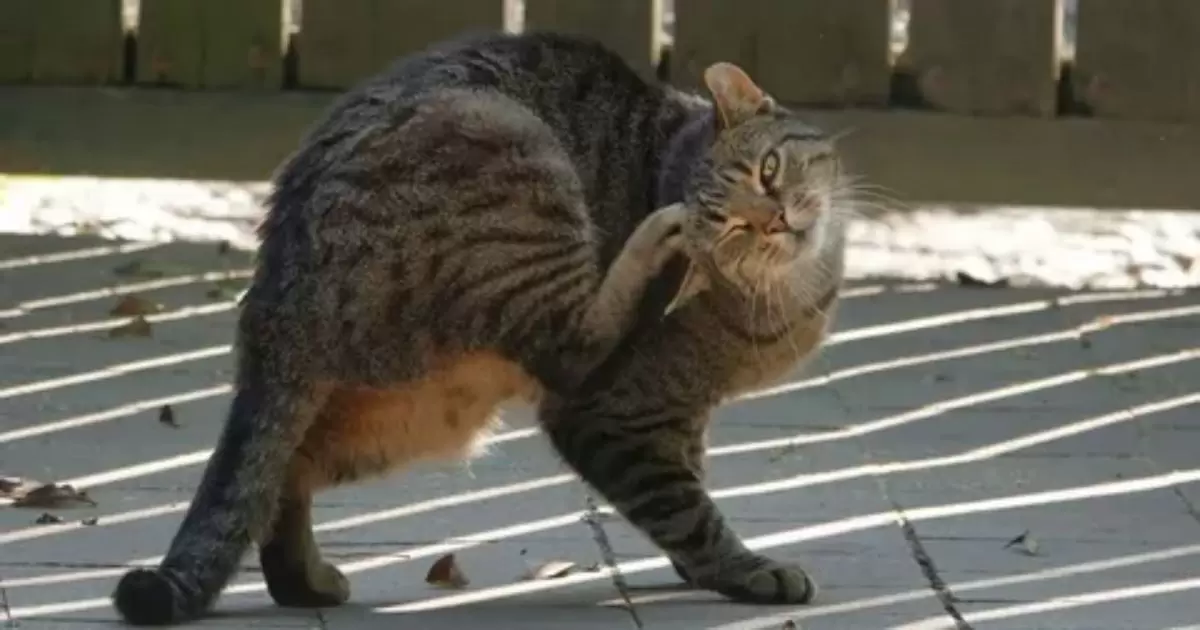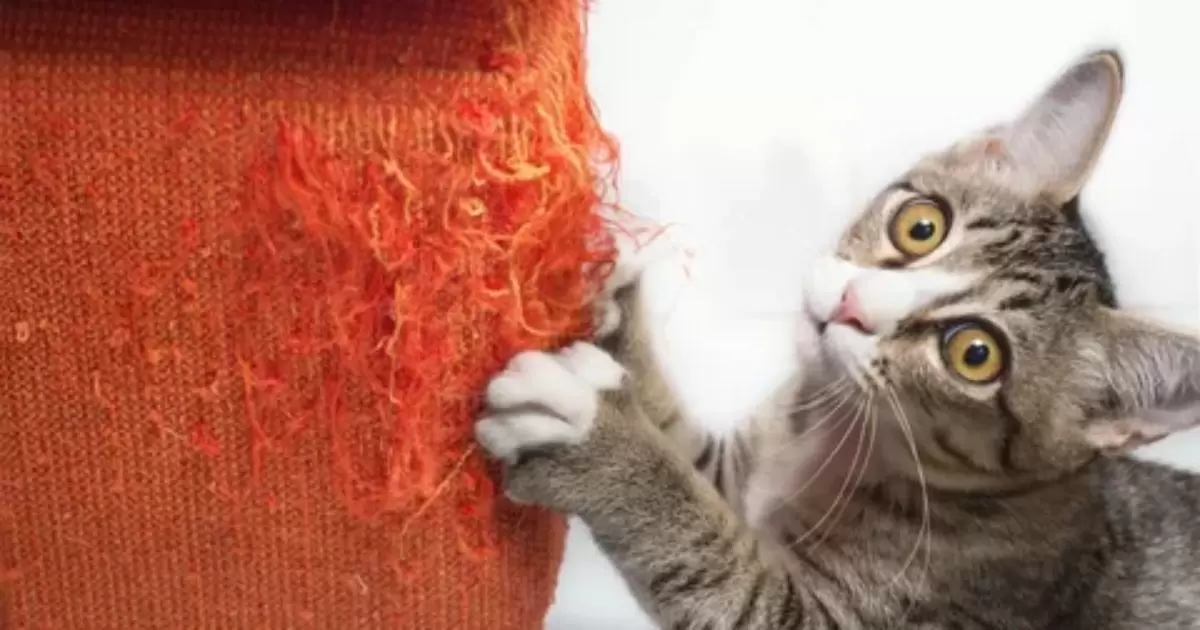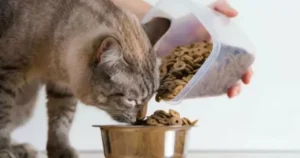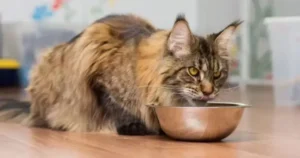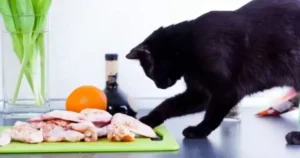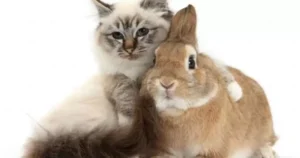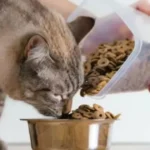Cats have an instinct to scratch. They scratch for many reasons, to remove the dead outer layer of their claws, mark their territory, and stretch their bodies. When a cat scratches near her food bowl, it is usually related to one of these natural behaviors.
Why is my cat scratching the floor near her food? As a cat owner, this behavior can be perplexing. We fill their bowls and expect them to eat, not tear up the floor. However, this scratching is communicating something important about our cat’s needs.
Scratching near her food could signify that her location is not ideal. Cats prefer to eat in quiet, low-traffic areas. If her food bowl is too close to noisy appliances, doors, or high human traffic, she may scratch to claim that space or show her discontent. Making sure her food is in a spot that makes her feel secure could help resolve the scratching.
Cat Food Location As Cause of Scratching
The sources indicate that the placement of a cat’s food bowl can trigger territorial scratching behaviors. As the article explains, cats prefer to eat in “quiet, low-traffic areas” where they feel calm and secure. However, if the food location has disruptive noise from appliances or doors or high human traffic, this causes stress and anxiety in cats while eating.
The noise and commotion likely make cats feel threatened about protecting their food. To resolve such scratching issues, experts recommend locating the food bowl away from these environmental stressors to create an ideal food zone. Having their eating territory can satisfy cats’ innate need to claim an area and reduce additional scratching behaviors.
Ideal Food Zone for Cats
Cats favor eating their food in a quiet, nonviolent, low-site visitors region where they experience stability. If a cat’s food bowl is placed in a hectic vicinity close to home equipment, doorways, or human foot site visitors, the cat may additionally perceive this as an undesirable and risky region to eat.
The cat will probably scratch near the meal bowl to assert that territory or talk that the place is unacceptable. Providing a perfect meal region that is quiet and calm can resolve scratching behavior.
Noise and Traffic Factors
Loud appliances, ringing telephones, slamming doors, and people taking walks near a cat’s food bowl can all be perceived as threats whilst the cat is in a susceptible consuming function. The noise and traffic can weigh down the cat’s senses, inflicting tension, fear, and lack of appetite.
Scratching close to the food is the cat’s try to claim ownership of that space and experience extra stability at the same time as consuming. Locating the meals far away from commotion can ease scratching.
Claiming Territory With Scratching
Cats scratch to mark an area with their scent from glands in their paws. By scratching near her food, a cat is communicating that this is her territory and reinforcing her ownership of that space. Scratching sends the message that this area around the food bowl belongs to her. Providing enough territory and vertical scratching posts can satisfy this innate territorial marking behavior.
Communicating Displeasure With Food Placement
When cats scratch around their food bowls, it can signal displeasure with where the bowl is located, such as if it is too close to noisy appliances or high-traffic areas. The scratching communicates the cat wants a more peaceful, comfortable place to eat. Observing the scratching and then adjusting the placement to an optimal food zone can help resolve this behavior.
Signaling Stress Via Scratching
Scratching or pawing around a food bowl is a way for cats to release stress and anxiety caused by environmental factors near the food. Loud noises, people walking by, or proximity to doors overwhelm them while eating. Providing a quiet, undisturbed area and monitoring to see if scratching decreases help address stress.
Adjusting Food Bowl Position
If a cat scratches around their food, first try adjusting the bowl location by moving it away from potential stressors like appliances and walking paths. Place it in a spot that feels like the cat’s territory. Seeing if a simple repositioning helps mitigate the scratching can provide insight.
Monitoring Scratching After Moving Food
After moving a cat’s food bowl to a calmer location, continue observing if the scratching behavior persists. If the scratching continues in the new spot, it may indicate additional underlying issues causing the cat stress. Ongoing monitoring provides information to best help the cat feel relaxed at mealtimes.
Natural Reasons Cats Scratch Near Food
Cats scratch near their food bowls due to innate behaviors and instincts. As articles explain, cats may scratch to remove the dead outer layers of their claws, mark territory with scent glands in their paws, or stretch their bodies. These natural scratching reasons are normal.
Providing a scratching post can satisfy those needs without damage to floors or carpets. Understanding why cats scratch can help owners address the root causes.
Potential Health Issues Causing Scratching
There are a few potential fitness troubles that might result in multiplied scratching behavior in cats. Conditions like skin irritations, joint pain from arthritis, and pressure/anxiety can all reason discomfort and agitation that results in immoderate scratching. Ruling out or addressing any medical causes is a critical first step before looking to deter scratching behaviors.
Skin Irritation and Discomfort
Cats may additionally begin scratching extra regularly if they have pores and skin irritation or soreness from conditions like hypersensitive reactions, insect bites, ringworm, or other infections. The scratching can in addition irritate their skin. Treating any underlying skin problems and imparting ways to assuage infection can assist solve scratching problems.
Arthritis and Joint Pain
Elderly cats or people with arthritis can also scratch near their meal bowls due to joint stiffness or aches when getting up from resting. Providing soft, multiplied feeders could make getting admission easier. Checking with a vet to rule out or cope with orthopedic problems is key.
Stress and Anxiety In Cats
Stress, anxiety, and nervousness also can motivate cats to scratch extra. Creating a nonviolent consuming sector and sticking to a feeding routine can help traumatic cats feel greater comfortable at mealtimes. Prescription medicinal drugs may also assist with high-stress tiers.
Deterring Cat From Scratching By Food
| Method | Description |
| Cat scratching deterrents | Special rough textures like Sticky Paws or double-sided tape that cats dislike scratching |
| Alternate items to scratch | Give appealing vertical and horizontal scratching posts to divert scratching |
| Reward good behavior | Give treats when the cat scratches appropriate items to positively reinforce |
| Reward good behavior | Give treats when the cat scratches appropriate items to positively reinforce |
These methods stop cats from scratching near their food bowls. Providing acceptable scratching posts while using deterrents on inappropriate areas guides the scratching to proper locations. Monitoring effectiveness and reinforcing rewards maximizes success. Addressing natural causes behind scratching is key.
Using Cat Scratching Deterrents
There are commercial deterrent sprays, shelf liners with uncomfortable textures, or aluminum foil that can be placed around the food bowl to discourage scratching. It’s important to also give cats approved alternative scratching posts/pads to redirect the instinct.
Providing Alternative Items To Scratch
Offering acceptable scratching posts, cardboard pads, and stable cat trees/perches near the food zone gives cats suitable outlets for scratching without damaging carpets or furniture. Rotating different textures keeps alternatives interesting. Cats Chew Their Food
FAQ’s
Why does my cat scratch near her empty food bowl?
Your cat is likely trying to cover up the scent from leftover food scraps as an instinctual behavior.
Is scratching by the food bowl a sign my cat doesn’t like her food?
Not necessarily, scratching is often an innate behavior not connected to food preferences. But you can try different foods to see if scratching lessens.
Why has my cat begun scratching around her bowl recently?
New scratching behaviors may want to symbolize stress or health problems. Check with your vet to rule out scientific reasons.
How can I get my cat to forestall scratching the ground by using her meals?
Try moving the food bowl area or using deterrents like double-sided sticky tape on the ground nearby.
What does scratching around the food bowl mean for cats?
It’s normal instinct to bury food remains, claim territory, remove claw sheaths, or stretch their bodies. Address basic needs to reduce scratching.
Conclusion
cats scratching the floor around their food bowls is often due to instincts and behaviors. As the sources explained, reasons can include burying food remains, marking territory with scent glands in their paws, removing dead outer claw layers, or stretching their bodies. This type of scratching is usually normal for cats.
However, the sources noted new scratching could potentially signal stress, anxiety, or health issues like skin conditions, arthritis, or digestive problems. Checking with a vet can identify or rule out medical causes. To curb floor scratching near her food, try moving the bowl to an ideal quiet location, using deterrents like double-sided tape, providing approved scratching posts, or rewarding good behavior.
Addressing root causes like territorial instincts often resolves the scratching. Understanding why cats scratch demystifies the behavior of owners. Most importantly, ensuring your cat’s basic needs are met keeps her content while saving your floors.
